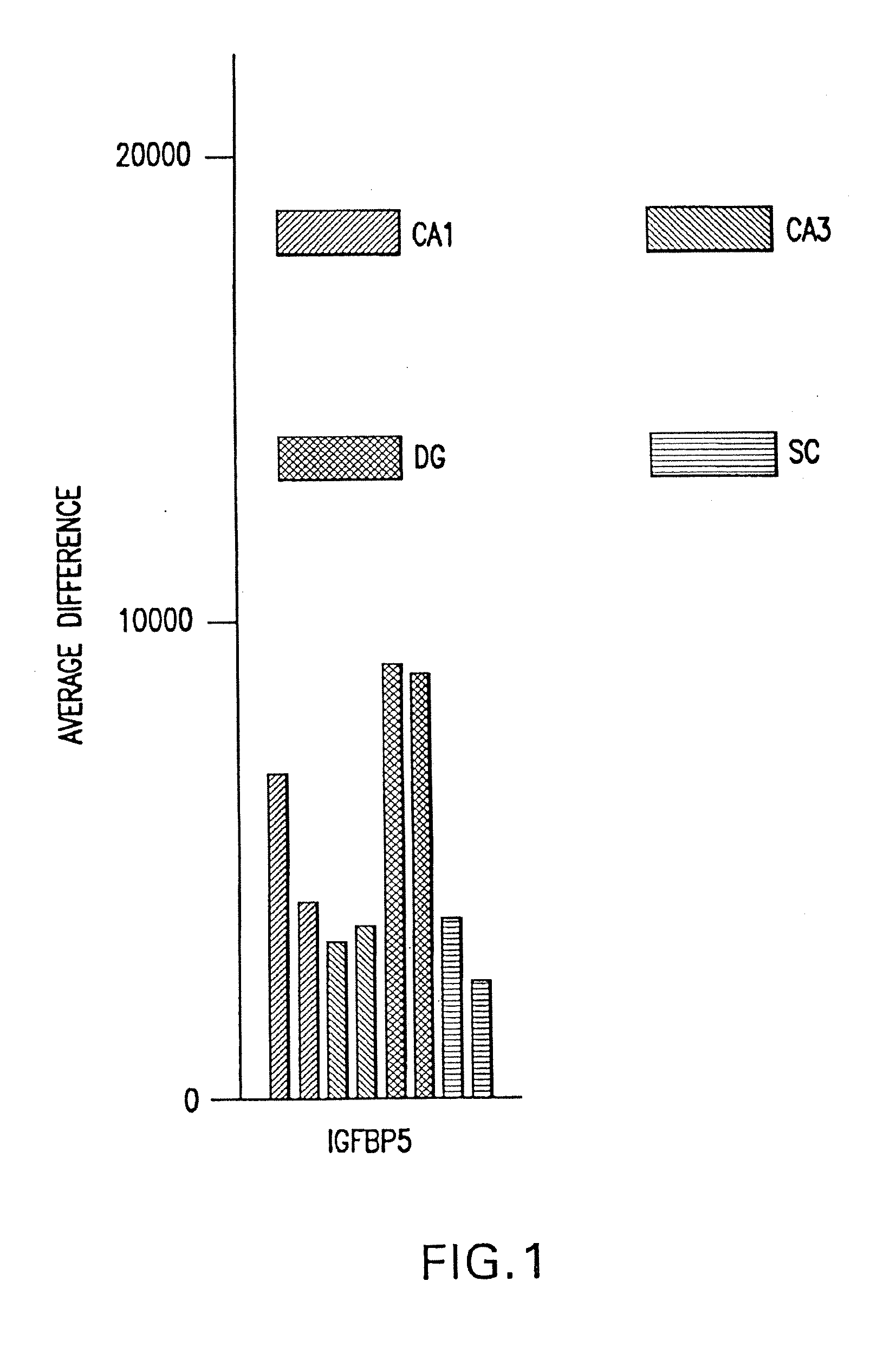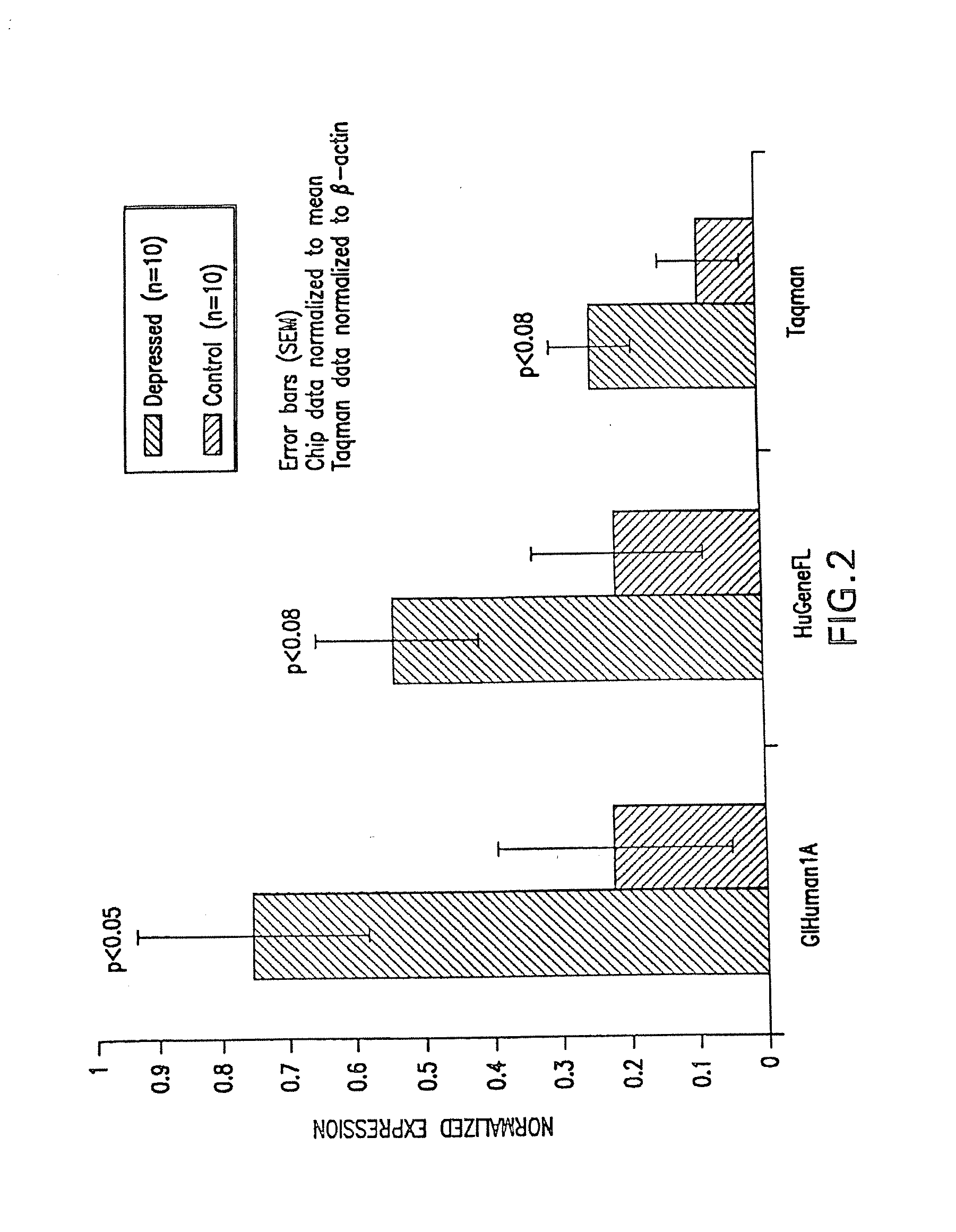Methods and compositions for treating neurological disorders
a neurodegenerative disease and composition technology, applied in the field of neurodegenerative diseases, can solve the problems of reducing the bioavailability of igfs, reducing neurogenesis in the dentate gyrus, and the biological half-life of igfs, and achieve the effect of increasing the expression of insulin-like growth factor binding proteins
- Summary
- Abstract
- Description
- Claims
- Application Information
AI Technical Summary
Benefits of technology
Problems solved by technology
Method used
Image
Examples
example 1
IGFBP-5 mRNA Shows Unique Expression in the Mouse Dentate Gyrus
[0187] The dentate gyrus is one of the unique areas in the brain that demonstrates neurogenesis. Analysis of microarray data, which compared mouse dentate gyrus (DG) with CA1, CA3 and spinal cord, demonstrated IGFBP-5 enriched expression in DG compared to other regions by microarray (FIG. 1A). This finding was observed in independent groups of mice and was confirmed by both Taqman real-time PCR (data not shown) and in situ hybridization (data not shown). In some model systems, IGFBP-5 potentiates the effect of IGF-I (Duan and Clemmons, 1998) although this has not been determined in the CNS. This data supports the idea that the relationship between IGFBP-5 and IGF-I may be directly important in neurogenesis. Also intriguing is the observation that IGF-I regulates IGFBP-5 gene expression in the brain (Ye and D'Ercole, 1998), so the enhanced IGFBP-5 in the dentate gyrus may be secondary to increased IGF-I activity in this ...
example 2
IGFBP-2 mRNA Shows Increased Expression in Fibroblasts from Subjects with Major Depression
[0188] Psychiatric disease has effects on gene expression in peripheral tissues (Lesch et al., 1996). It has been has observed that fibroblast cell lines derived from skin biopsies from subjects with major depression show biochemical differences in signal transduction pathways when compared with cells from control subjects (Fridolin Sulser, unpublished data). To identify transcriptional differences between these two populations, the cell lines were profiled by microarray. IGFBP-2 showed a statistically significant increase in expression in the depressed population. This finding was reproduced using two microarray designs, which have different probe sequences and was confirmed by Taqman real-time PCR (FIG. 2). These data indicate that IGFBP-2 mRNA or protein levels in the periphery (from serum, leukocytes or skin biopsy) may be used as a diagnostic marker to diagnose depression in human subject...
example 3
IGFBP-2 mRNA Shows Slightly Increased Expression in Brain Tissue from Subjects with Major Depression
[0189] Human brain tissues of Brodmann area 21 were obtained from the Stanley Foundation and profiled by microarray (FIG. 3). A slight increase in IGFBP-2 was noted. Although this did not approach statistical significance (p<0.2), the trend was the same as that seen in the fibroblasts for this gene.
PUM
| Property | Measurement | Unit |
|---|---|---|
| Temperature | aaaaa | aaaaa |
| Temperature | aaaaa | aaaaa |
| Temperature | aaaaa | aaaaa |
Abstract
Description
Claims
Application Information
 Login to View More
Login to View More - R&D
- Intellectual Property
- Life Sciences
- Materials
- Tech Scout
- Unparalleled Data Quality
- Higher Quality Content
- 60% Fewer Hallucinations
Browse by: Latest US Patents, China's latest patents, Technical Efficacy Thesaurus, Application Domain, Technology Topic, Popular Technical Reports.
© 2025 PatSnap. All rights reserved.Legal|Privacy policy|Modern Slavery Act Transparency Statement|Sitemap|About US| Contact US: help@patsnap.com



